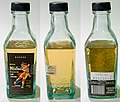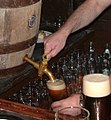Portal:Drink
The Drink Portal
A portal dedicated to all beverages
Introduction

A drink or beverage is a liquid intended for human consumption. In addition to their basic function of satisfying thirst, drinks play important roles in human culture. Common types of drinks include plain drinking water, milk, juice, smoothies and soft drinks. Traditionally warm beverages include coffee, tea, and hot chocolate. Caffeinated drinks that contain the stimulant caffeine have a long history.
In addition, alcoholic drinks such as wine, beer, and liquor, which contain the drug ethanol, have been part of human culture for more than 8,000 years. Non-alcoholic drinks often signify drinks that would normally contain alcohol, such as beer, wine and cocktails, but are made with a sufficiently low concentration of alcohol by volume. The category includes drinks that have undergone an alcohol removal process such as non-alcoholic beers and de-alcoholized wines. (Full article...)
Selected article -
A member of the Cabernet family of grapes, the name "Carménère" originates from the French word for crimson (carmin) which refers to the brilliant crimson colour of the autumn foliage before leaf-fall. The grape is also known as Grande Vidure, a historic Bordeaux synonym, although current European Union regulations prohibit imports under this name into the European Union. Along with Cabernet Sauvignon, Cabernet Franc, Merlot, Malbec and Petit Verdot, Carménère is considered one of the original six red grapes of Bordeaux.
Now rarely found in France, the world's largest area planted with this variety is in Chile, with more than 8,800 hectares (2009) cultivated in the Central Valley. As such, Chile produces the vast majority of Carménère wines available today and as the Chilean wine industry grows, more experimentation is being carried out on Carménère's potential as a blending grape, especially with Cabernet Sauvignon. It is considered the emblematic strain of Chilean wine.
Carménère is also grown in Italy's Eastern Veneto and Friuli-Venezia Giulia regions, in Argentina, and in smaller quantities in California and Walla Walla (Washington and Oregon) in the United States. (Full article...)
Did you know? -
- ... that Assyrian Christian couples drink dust from the tombs of martyrs and are crowned during their weddings?
- ... that the "Mayor of Picklesburgh" is decided by a pickle juice drinking competition?
- ... that salt marsh snakes drink only rainwater?
- ... that Ben Phillips replaced his friend's hair gel with superglue, put Viagra in his sports drink, and placed him on a lake while he slept on an inflatable mattress?
- ... that The Drunkard's Progress suggests that a single social drink leads to poverty, crime, and suicide?
- ... that Phil Elverum recorded Don't Wake Me Up nocturnally, while "drinking pots of black tea all night"?
General images -
Selected image -

Selected biography -
Mohamed Yehia Zakaria (born May 10, 1938) is an Emirati businessman of Egyptian origin. He is the longest-serving chief executive of the beverage industry in the Middle East. He is the co-founder and was chief executive of Dubai Refreshments (Pepsi), in Dubai, and institutionalized the soft drink industry in the Middle East. (Full article...)
Selected quote -
| “ | It is nice when you can sit back with some friends, drink some beer and have a good time. | ” |
| — Dave Matthews |
Selected ingredient -
Many varieties of rice have been bred to improve crop quality and productivity. Biotechnology has created Green Revolution rice able to produce high yields when supplied with nitrogen fertiliser and managed intensively. Other products are rice able to express human proteins for medicinal use; flood-tolerant or deepwater rice; and drought-tolerant and salt-tolerant varieties. Rice is used as a model organism in biology.
Dry rice grain is milled to remove the outer layers; depending on how much is removed, products range from brown rice to rice with germ and white rice. Some is parboiled to make it easy to cook. Rice contains no gluten; it provides protein but not all the essential amino acids needed for good health. Rice of different types is eaten around the world. Long-grain rice tends to stay intact on cooking; medium-grain rice is stickier, and is used for sweet dishes, and in Italy for risotto; and sticky short-grain rice is used in Japanese sushi as it keeps its shape when cooked. White rice when cooked contains 29% carbohydrate and 2% protein, with some manganese. Golden rice is a variety produced by genetic engineering to contain vitamin A. (Full article...)Topics
| General topics: | Bartending • Bottling • Drinking • Drinking water • Bottled water • Mineral water • Coffee • Energy drink • Juice • Tea • Milk • Plant milk • Pasteurization • Refrigeration • Steeping • Water purification |
| Alcoholic beverages: | Beer • Brandy • Brewing • Caffeinated alcoholic drinks • Cider • Cocktails • Distillation • Fermentation • Hard soda • Liquor • Liqueur • Malt drink • Mead • Proof • Rice Wine • Schnapps • Vodka • Whiskey • Wine |
| Soft Drinks: | Carbonation • Cola • Orange soft drink • Frozen carbonated drink • Root beer • Soda water • Lithia water • |
| Miscellaneous: | Drink industry • Lemonade • Limeade • Orange drink • Slush (beverage) |
List articles
Subcategories
Related portals
WikiProjects


WikiProject Food & Drink is an association of Wikipedians with an interest in culinary-related subjects. They have come together to co-ordinate the development of food and drink articles here on Wikipedia as well as the many subjects related to food such as foodservice, catering and restaurants. If you wish to learn more about these subjects as well as get involved, please visit the project.
 WikiProject Beer – covers Wikipedia's coverage of beer and breweries and microbreweries
WikiProject Beer – covers Wikipedia's coverage of beer and breweries and microbreweries
![]() WikiProject Wine – aims to compile thorough and accurate information on different vineyards, wineries and varieties of wines, including but not limited to their qualities, origins, and uses.
WikiProject Wine – aims to compile thorough and accurate information on different vineyards, wineries and varieties of wines, including but not limited to their qualities, origins, and uses.
| Child projects: | Task forces: (All inactive) |
| Related projects: | |
Things you can do
 |
Here are some tasks awaiting attention:
|
Associated Wikimedia
The following Wikimedia Foundation sister projects provide more on this subject:
-
Commons
Free media repository -
Wikibooks
Free textbooks and manuals -
Wikidata
Free knowledge base -
Wikinews
Free-content news -
Wikiquote
Collection of quotations -
Wikisource
Free-content library -
Wikiversity
Free learning tools -
Wiktionary
Dictionary and thesaurus








































































